#although u might be able to go down similar interpretative routes with them??
Text
i'm literally going insane about the symbolic potential around Warden's gloves and glasses. like. yellow is the primary color of his silly little coping mechanism escapist amusement park that he fortified away from the rest of the world. it's the color of his custom-built, 100% hand-made mirage where he is always in full control. he's so firmly stuck in his own delusional perception that his actual vision is tinted and warped by it. yellow. it's all fucking yellow. he literally can't see the world for what it is and that's by design because who is forcing him to wear those dumb glasses? and motherfucker even wears them to sleep like are you kidding me?? not a single second spent outside of the safety of his personal fantasy, not a single second spent confronted with the horrors he's been surrounded with from childhood and continues to choose to be surrounded with. always a layer of canary away from life as it is. and the fucking gloves, too!! this marker of distance and sterility on a guy with a moral superiority complex who, due to his holier-than-thou coping mechanism narcissism, isolates himself from everyone around him because they're beneath him or some shit when in reality he's desperate desperate desperate for connection and terrified of being abandoned but can't fucking admit it or achieve any form of human proximity because of his patrilineal brain damage that dictates that big strong manboys can't have feelings and because women are a foreign concept to him and he's "better than" everyone anyway. and the empathy has been pavloved out of him one dead puppy at a time. so he wears the goddamn gloves and he wears them to sleep and he wears them when he's supposed to be intimate with someone. he's removed himself from everything and everyone and he's ruining his life, and the lives of all those he holds hostage so that he doesn't end up alone, because of it but he can't help himself because he's so thoroughly and intentionally wrapped up in his own bullshit that he keeps reinforcing in a never ending cycle of his own creation. FUCK!!!!
yes, i'm reading too much into the stupid joke character from the stupid joke show, thank you for asking <3
#worm rambles#text#superjail#its a good idea in isolation but it falters a bit in the presence of the many other permanently bespectacled characters#like mistress and alice etc#although u might be able to go down similar interpretative routes with them??#but in alices case the implications would be...bad#like to imply that a trans character whose identity is already consistently being mocked is now metaphorically designated as delusional is#actually disgusting#then again her and warden have a strange degree of overlap in aesthetic and theme#theyre a little like fucked up fun house mirror images of one another#but that could be its own post tbh
27 notes
·
View notes
Text
Hymnstoke XIV
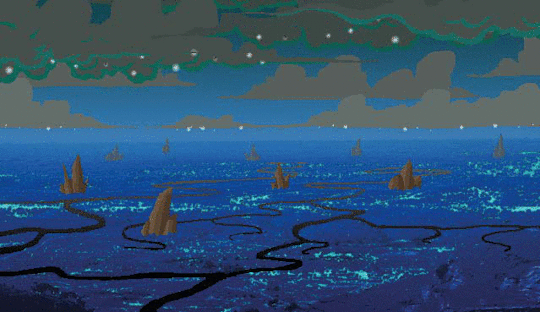
Like Act 2, Act 4 opens with a walkaround game.
I didn't comment much on the game at the beginning of Act 2, despite it being one of those much-discussed multimedia elements that make Homestuck so distinctive. In Act 2, the movement from linear story to game serves several purposes. First, it demonstrates an increase in scope, both in terms of Homestuck's story and in relation to Hussie's previous effort, Problem Sleuth. While Act 1 incorporated a couple of new elements not seen in other MSPA comics, such as protagonists capable of speech and a handful of simple videos, the Act 2 walkaround is the first dramatic increase in what readers could have reasonably expected from the comic at the time.
Secondly, the novel concept of incorporating a game into the story corresponds to and emphasizes the novel concept of SBURB within the narrative of Homestuck. Just as the world in which John now finds himself is completely new and unexpected, so too are the readers introduced to this world through a new and unexpected medium. This world is even called the "Medium"—and surrounding a space (Skaia) described as a crucible of pure creation. I previously discussed the significance of SBURB's geography in regards to Gnosticism, but one could also interpret it as a statement on Homestuck as a creative enterprise. A crucible of pure creation through which a new world, or a new mode of expression, will be built. Like how John and friends attempt to create a new world from the fragments of the old, Hussie creates a new kind of story from the fragments of all types of storytelling that came before it. Image, text, video, sound, game—Homestuck strings together these disparate modes of expression into an original creation. In short, the method by which Homestuck is presented mirrors its explicit thematic content.
Wikipedia defines phenomenology as "the philosophical study of the structures of experience and consciousness." Remember how I mentioned that the modernists were often concerned with the conscious and subconscious, and how many attempted to reach truth by depicting the subconscious? Similar concept here.
I was introduced to the term "phenomenology" in relation to art history. In particular, my professor applied the term to modernist painting and sculpture that was designed so that the act of experiencing it changes its meaning. Let's take the following sculpture:
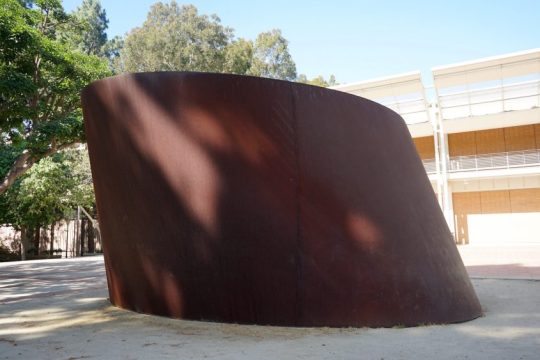
"Sculpture?" you may ask. Yes, I know. It looks more like a misshapen industrial structure. The problem with this sculpture is that no single photograph can truly depict it. Here's the same sculpture from a different vantage:

Another:

Still another:

Top down:

Is this sculpture broader at the bottom or at the top? What shape is it, exactly? You can find this sculpture at the University of California, Los Angeles, and you can even go inside it through the opening visible in some of the photographs. Inside, it takes on a completely different appearance, although unfortunately I couldn't find any good pictures of the inside that didn't have a gigantic Getty Images watermark on them.
In art, this phenomenological experience often boils down to optical illusion or a similar technical trick that appears novel at first but lacks much substance beyond its presentation. What meaning can we derive from this experiment or others like it?
I believe that the phenomenological creations of the modernists eventually reached an apotheosis in a more contemporary form of creative expression: Video games.
The way the player perceives a video game, even a video game you might consider simplistic or linear, is directly affected by how the player plays the game. Take, say, Super Mario Bros. (1985) for the Nintendo Entertainment System. In this game, the player moves Mario left to right to reach a fixed goal. But even this game is affected immensely by the innumerable choices each player makes in playing the game. For an extreme example, compare how a speed run of Super Mario Bros. looks compared to any casual experience of the game. Some elements of the speed run even involve elements assuredly not intended by the game's creator (glitches, for instance). But even at a less extreme level, every player's experience of Super Mario Bros. will differ depending on the routes they take to reach the end, the strategies they employ to evade obstacles, or even the amount of times they die before finally succeeding.
Why do I bring this up? The concept of phenomenology ties into Homestuck's "reader participation" elements, both via the prompt suggestions early on and the more psychological effect the fandom has on Homestuck's development in its back half. Of these two "reader participation" elements, the latter is the one that is probably better described as "phenomenological," in that it is the readership's perspective of Homestuck that eventually drives its trajectory (as opposed to the prompt suggestions, from which Hussie could pick and choose at will). In the back half of Homestuck, the narrative plays more and more on the author's interpretation of the readership's interpretation of the narrative, becoming a perspectival mobius double reach-around where the true driver of the narrative's creation becomes increasingly unclear.
But more specifically, I want to discuss this walkaround game at the beginning of Act 4 in particular. Compared to the one at the beginning of Act 2, this walkaround is not increasing Homestuck's scope. John is entering a new location, but the experience is less novel than entering the Medium in Act 2, both in terms of John's perspective and the reader's. While the Act 4 walkaround features mechanical improvements (inventory, combat) over the Act 2 walkaround, it is still essentially the same thing: a video game. The reader has seen this before in Homestuck. It's not new.
I cannot speak for the experience of every reader, but each time I read Homestuck I am tempted to skip this walkaround entirely. The combat mechanics are banal, the camera is zoomed too close to John to allow for satisfying exploration of an unfamiliar world. In Act 2, the walkaround takes place in an area with which the reader is already geographically acquainted (John's house), so the camera issues are less apparent. But trying to navigate this twisting maze of blue paths, surrounded on all sides by nondescript rocks and mushrooms, can become frustrating. Even if I consult the supplementary map image, I find it somewhat difficult to figure out where I am and where I'm supposed to go.
Which is just the thing. The reader is not supposed to go anywhere. There is no real resolution to this walkaround. The same, in fact, can be said for every walkaround, and we will continue to get amazingly nonessential walkarounds in the acts to come. What does the reader miss if they skip this Act 4 walkaround? Some tedious exposition on the nature of John's planet, its consorts, its customs. Superfluous W O R L D B U I L D I N G that the Homestuck narrative is quick to forget from henceforth on.
It kind of makes me want to, shall we say, skip to the end.
In Act 5, Vriska and Tavros will discuss how the way one plays a game affects the way the game is perceived. Hardcore speed runner Vriska will take my side of the argument and skip what she can; Tavros, more in line with readers inclined to learn as much about SBURB's lore as possible, will argue instead for assiduously completing every task. This conflict—between speed and lore, content and fluff, meat and candy if you will—eventually becomes the core and final dichotomy of Homestuck. But in Homestuck's later stages, the characters and narrative will apply this dichotomy not to how we experience video games, but how we experience all art—and how we experience our actual lives. I intend to trace that development, and this walkaround serves as a fine introduction.
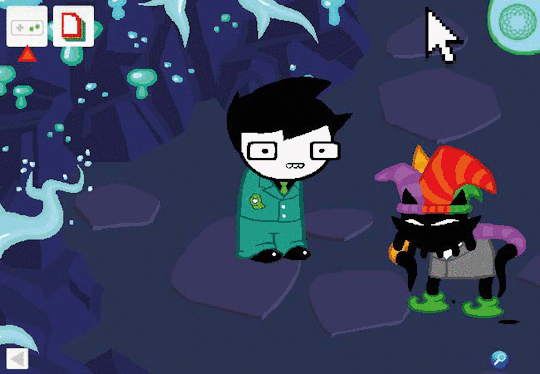
In a few years, Flash will be deprecated and you'll only be able to experience this walkaround through this series of images. I don't know who created these images, or whether laziness or incompetency made them so shitty and SBaHJ-esque. But I give that person props for maintaining that sense of "God this sucks, can I just skip it?" Good job, intern.
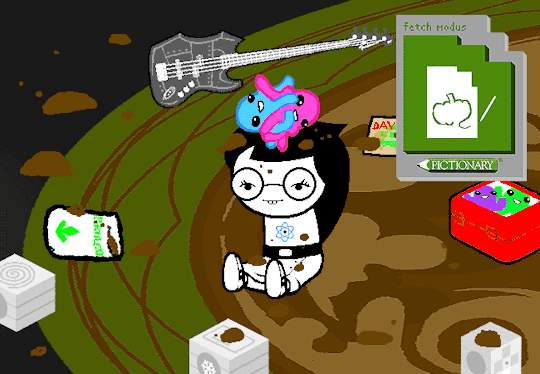
You switch to PICTIONARY, a choice based on a strong whim from the mysterious ethers of democracy.
Another one of those traps, like the suggestion prompts. Wow! The readers get to pick Jade's fetch modus! What an amazing display of reader/author interaction! Except Jade's fetch modus doesn't matter. In fact, as we transition into this next phase of the story, nobody's fetch modus will matter. The fact that all of Jade's possible fetch modii are total jokes only emphasizes the point.
I mentioned in the previous Hymnstoke that we're entering what I'm calling the "clockwork" part of Homestuck. In this part, Homestuck's audience has the least amount of control over its progression. While the suggestion prompts were mostly irrelevant because Hussie could pick whatever prompt he wanted, they occasionally paved actual story or character developments ("Become the mayor of Can Town") or formed memetic jokes that would mutate over the course of Homestuck into part of its mythos. And in Act 6, the immensity of the Homestuck fandom and its increasingly vocal demands will lead to a more subtle transition in what Homestuck becomes—the mobius double reach-around I mentioned previously. But here, in the clockwork part of the story, it's more Hussie than anywhere else. Of course it would be. It's Dirk, Hussie's analogue (connected via a series of motifs like horses and robotics), that comes to represent the Meat side of storytelling, that describes the way a story should be told as a perfect machine. An unfocused, nebulous gaggle of "readers" cannot hope to coordinate among themselves to create something so precise and efficient. Their strengths lie in different directions.
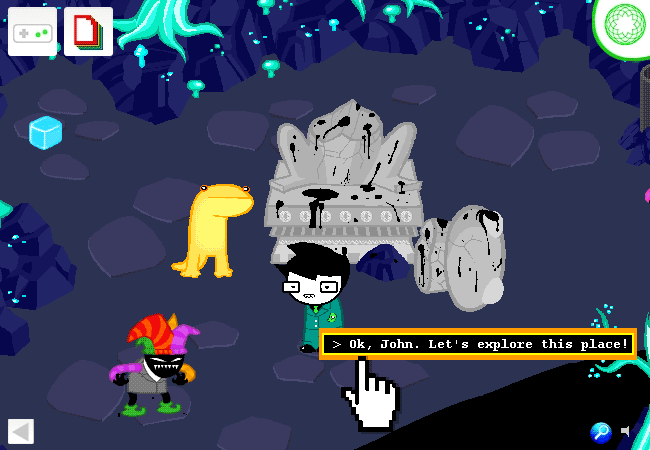
Ok, have at it! If you're at a loss, click the controller button up there.
This may or may not mean anything to you depending on your current perspective.
As it turns out, the story retreads everything that happens in the Act 4 walkaround anyway, making it even less relevant. Even Crumplehat and the Salamander Wizard appear as the walkaround's events are depicted from PM's perspective. This recap is actually pretty extensive, similar to the shitty SBaHJified image walkthrough that got put up in anticipation of Flash's deprecation.
I wonder if Hussie was self-conscious about people's patience for the walkaround? Or maybe he already anticipated Flash would not last forever? Perhaps he added this recap for accessibility reasons, in case of visually-impaired readers? Maybe he felt some new insight would come from seeing the same events replicated from a different character's viewpoint? Or maybe he simply wanted to reveal that the person speaking to John during the walkaround was PM instead of WV?
I'm doing exactly what I said I wouldn't do and trying to delve into Hussie's psyche. As it stands, the addition of this recap makes certain elements of the walkaround mandatory experiences for the reader to progress, as opposed to the walkaround itself which can be ended without experiencing anything. I'll leave the discussion by reiterating the second part of the quoted text:
This may or may not mean anything to you depending on your current perspective.
And I think it's safe to say our "current perspective" is much different than those who read this first.
13 notes
·
View notes